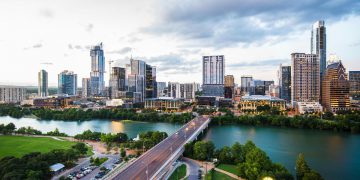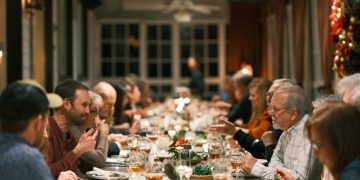
When Houston was incorporated in 1837, its founders decided to split the city into wards. Originally, there were four wards. However, today, there are six distinct Houston wards, each with a different culture and vibe. If you’re moving to the city and you’re not sure which ward is the best place for you, keep reading to learn everything you need to know about the six wards of Houston.
Whether you’re looking for culture, diversity, entertainment, or community, you’ll have your pick in one of these Houston neighborhoods.
First Ward

The First Ward is in the northwest section of downtown Houston and is a historic district. In fact, it’s so close to downtown that those living in the unique mix of Victorian houses, old cottages, bungalows, and modern townhouses have a short 5-minute commute to the city center. This proximity to downtown makes the First Ward an ideal place for young professionals.
Additionally, a thriving arts district is also emerging in this Houston ward. The First Ward Arts District offers trendy galleries, cafés, and restaurants. The area has a strong sense of community with holiday parties, beautification days, and a community garden. Families moving to this ward often find that they’re so close to everything they need, it’s easier to opt for car storage in Houston and just walk or take the bus to wherever they want to go.
Allen’s Landing Park, which is considered the Plymouth Rock of Houston, is also in the First Ward. In 1836, this was the site where Houston founders John and Augustus Allen stepped ashore. Today, the 1.76-acre park features a terrace overlooking the bayou, a launch spot for kayaks and canoes, trails and walkways, and a large grass lawn. This is also the spot where the Asian American community and the Texas Dragon Boat Association hold their annual dragon boat race in the spring.
Second Ward
Since the community in the Second Ward is largely Mexican American, it also goes by the name “Segundo Barrio,” which is Spanish for “second neighborhood.” This Houston ward is east of the city. At one point, the area was mainly filled with industrial buildings. However, as those businesses moved elsewhere or closed down, developers started to transform the buildings into lofts. Additionally, many of the buildings in the Second Ward were built in the 1920s, so the neighborhood has some art-deco flair to it.

One major landmark in the Second Ward is Our Lady of Guadalupe Catholic Church. This church, which was built in 1911, was the first Mexican-American church constructed in Houston. Today, the church serves more than 3,500 families, and most of its masses are held in Spanish. The Our Lady of Guadalupe Catholic School is also connected to the church and is the oldest Catholic school in the city.
Third Ward
Perhaps no ward in Houston has gone through more diverse changes than the historic Third Ward, which has seen a Renaissance of restaurants and cultural activity in recent years. In the 1800s, Houston’s Third Ward was a neighborhood of Victorian houses and wealthy residents. However, construction of Union Station in 1911 saw the area become more industrial and less residential. Gentrification is slowly changing the neighborhood as people restore the old homes and developers build new townhouses. Most of the single-family homes in the area are sturdy brick houses. Today, it’s famous for being the ward where Grammy award–winning singer Beyoncé was born.
The Third Ward also is home to Texas Southern University and the University of Houston. These educational institutions are known for their stellar programs such as pharmacy, law, and education. Combined, their enrollment is close to 50,000 students. Since students come from all over the world to attend these Third Ward colleges, many find it convenient to simply rent a Houston self storage unit for their belongings while they’re on break (and between dorm rooms) instead of hauling everything back and forth.
Fourth Ward
The Fourth Ward is located just southwest of downtown Houston. However, as the city continued to expand, many of the homes and businesses in this ward were torn down. This expansion continued until, by 1980, only one residential area was left in the Fourth Ward. Currently, this area is the smallest neighborhood in Houston, and it consists mainly of apartments and townhouses.
While the expanding city has taken many of the historic homes and buildings in the Fourth Ward neighborhood, not all have been lost. Sam Houston Park was established to keep some of the culture and buildings of historical Houston intact. Inside the park, homes such The Old Place (the oldest structure in the county) and the Kellum-Noble House (the oldest brick home in the city) are open for tours. The park is also home to Heritage Society Museum, a small museum committed to saving and showcasing Houston’s past.

Fifth Ward
The Fifth Ward is northeast of downtown Houston. It’s not one of the original wards designated by the founders of the city. Instead, the Fifth Ward was created from a northeast section of the First Ward and a northern section of the Second Ward. This area has witnessed many significant transformations during the past few years.
Lately, there have been more and more people looking for single-family homes throughout the city. Developers have noticed this and are attracted to the Fifth Ward because of its low real estate prices. Additionally, there’s a plan to bring the once-popular DeLuxe Theatre back to life with a 125-seat performing arts theater, retail space, laboratory, and classroom space.
Residents of this community also have access to Finnigan Park and Community Center. Here, they can enjoy a swimming pool, lighted tennis courts and sports fields, a playground, a 0.65-mile biking and walking trail, and an indoor gym and weight room. The park also offers fitness programs like adult aerobics and yoga. Or, residents can go to Swiney Community Center and take advantage of the basketball court and playground located there.
Sixth Ward
While the Sixth Ward is commonly called the “Old Sixth Ward,” it’s also not one of the original wards. It was formed in 1876 from a northern part of the Fourth Ward. Many of the buildings that are still standing, such as the bungalows and corner stores, were originally built between 1870 and 1900. Additionally, the Old Sixth Ward features the largest cluster of Victorian-era homes in the area.
There is a strong sense of community as residents fight to save these old homes. In fact, in 2006, the Houston Chronicle named the Old Sixth Ward as the city’s “Best Hidden Neighborhood.” This is a neighborhood that plans family-friendly activities, monthly happy hours, community meetings, and maintains an active website filled with helpful residential information.
The Sixth Ward is the first historic district in Houston to have more than 200 properties saved from demolition after the City Council voted to create a historic district for them. New residents who are taking on the challenge of restoring a historic home in this neighborhood (which has been on the National Register of Historic Places since 1978) may find it easier to store their furniture in Houston self storage as they renovate. Then, they can also enjoy the charm that makes Sixth Ward such a popular neighborhood in Houston.
Whether you’re looking for a good price on a house, an up-and-coming neighborhood, or a historic home you can restore, you’ll be sure to find a neighborhood that suits your needs in one of the six Houston wards.
Ready to Move to Houston? Check out these 8 important tips before you start planning.







